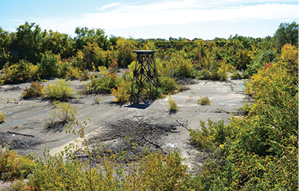
By Joe Jarosz
Northeast News
October 22, 2014
KANSAS CITY, Missouri – First, they took a look at Independence Avenue.
Now, students with the Kansas City Design Center are looking at Kessler Park.
Last Wednesday night, the first of many public engagement meetings was held between Northeast residents and the seven students involved with the Kessler Park vision study. The project will focus on repurposing the abandoned water reservoir, as well as an overall vision study of Kessler Park which would include new amenities and a master plan for the park. The boundaries defined for the project include Indiana Avenue on the east, Cliff Drive to the north, Paseo Boulevard on the west and Admiral Boulevard to the south.
During the 2012-13 academic year, the Kansas City Design Center, in collaboration with Northeast Alliance Together (NEAT) and the KCMO Planning Department, completed an urban vision study of Independence Avenue and the Historic Northeast neighborhood. In a previous story by former managing editor Leslie Collins, students gathered information about the Independence Avenue Corridor to study the Northeast and create designs for different sections along the corridor. Students studied everything from peak bus times to density and topography influences to area roads that affect the Northeast. Some of the design ideas included repurposing the shuttered Thacher Elementary School into a performing arts space and reworking streets to better connect Northeast to downtown.
Aaron Bisch and Lindsey Brockhouse, the two students who led the presentation, said the 303-acre park designed by George Kessler contains topography unique to Kansas City. The north side of the park is bordered by a cliff physically separating the park from the East Bottoms and Cliff Drive, provides a vehicular perspective through Kessler Park. Amenities and attractions such as a professional disc golf course, bike trails, memorials, and sculpture are all located within the park.
KC Design Center Professor Vladimir Krstic said this project is a continuation of their efforts to provide service learning and contributions to the ongoing urban development efforts of the city. The primary beneficiaries of the project include the Kansas City Parks and Recreation Department, Northeast Alliance Together (NEAT), Green Space Committee and the surrounding neighborhoods.
“This is building on the efforts and studies done before on enhancing the development of the Northeast,” Kristic said.
Bisch went on to add their goal is to determine how to turn Kessler Park into a citywide destination. At the same time, they’d also like to enable greater community use within the park.
“We want the people in the Northeast to use the park in a better way or more extensively than they currently do,” Bisch said.
Brockhouse noted that the students are looking at two aspects of the park, how it affects the metro and the surrounding community. Bisch said the Northeast is a hotspot for modern and organic initiatives popping up.
“We want to build on all these projects moving forward and aiding and working on the same goal as everyone else in the area,” Bisch said.
Since the park has so much to offer, the students also broke the park into four different zones to better grasp the magnitude of the park. The students, after having established the zones, began creating 3D models to examine the different, “little parks” or zones, and the park, as a whole.
The students then looked at different case studies, to better understand how they can turn their findings on the park and the reservoir into a more integrated study. The group showed photos of Olympic Park in Seattle and Paddington Reservoir Gardens in Sydney, Australia, and compared the likeness of those parks to Kessler Park.
“We want to also better understand your ideas and see what you think,” Bisch said to the group of about 12 community members who attended the meeting. Throughout the public input portion, those invested in the park noted how they’d like to see the reservoir cleaned up and turned into either a skate park or an amphitheater. Participants also noted that if more activities and amenities are introduced to Kessler Park – with Richard Plackemeier, as one idea, installing picnic tables and shelters – then more people from throughout the city will head to the park which would result in less crime and security concerns for the area.
“The simplest ideas don’t cost a lot or take a lot of planning,” Plackemeier said.
After the meeting, Plackemeier said he was hoping to hear more ideas that could be implemented sooner, rather than later. Still, he said he appreciates the students taking an academic approach to looking at the park.
“There’s a lot of stuff going on up there already,” Plackemeier said. “Later on they [the students] are going to come up with some more specific ideas but I thought they were going to get more into that tonight. At least they have ideas and they’re exercising their minds which is good to get people together and brainstorm.”
The next public engagement session is currently slated for November, but the group discussed holding public meetings more frequently than just once a month.















